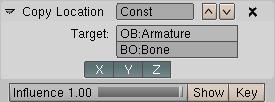Blender 3D: Noob to Pro/Advanced Tutorials/Advanced Animation/Guided tour/Const/cl
|
|
Applicable Blender version: 2.4x. |
Copy Location
[edit | edit source]The Copy Location constraint does as the name states: it will copy the location of the target to the source (constrained object). Less Influence will drag the constrained object less and less to the target.
If it's an armature, a new field will appear to let you tell which bone will be the target. Don't forget TABKEY completion while writing the name of your object/bone!
You can tell Blender to work only on the selected axis. Many uses are possible :)
The Constraint Panel
[edit | edit source]- The Target field will let you select which Object the constraint holder will follow.
Where To Use It
[edit | edit source]Most of the time this little constraint is useful to stick objects to one another. By playing with the Influence you can tell when it will work, when it will remain motionless.
A good use of it is to ask a character to pick up something. By having a bone or empty for each side of the relationship (hand <-> glass), as the hand approaches the glass, you can align the two empties and fire the constraint up (1.00) to stick them together. You add another child-bone in the middle of the hand to tell where the glass will be. Thus moving the hand will move the glass. On the side of the glass just add an empty and make it parent of the glass. Add a copy location to the empty pointing to the bone in the hand we just did. There you go. Of course when the hand rotates the glass will not. For that you will need to add a Copy Rotation Constraint.
Before Blender 2.40, the above method was a good way of faking parent relationship without rotation. But now we have the hinge option which does the same.
Create this kind of tracking device using the X Y Z toggle button


